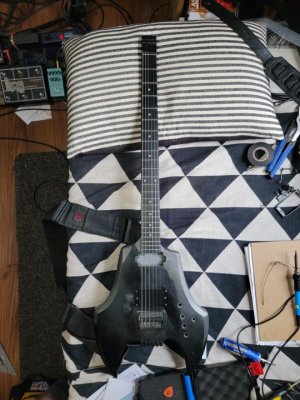If I am imagining my modified LP correctly in my head, if the scale length midpoint is no longer at 12th and is higher up the neck due to the bridge being moved back a few inches, all the upper frets will have to be moved back and compressed if you want to keep the neck the same length.
You'd end up with lower frets the same size and very narrow upper frets. I think all the fret locations would have to be redrawn to redistribute the 22 frets along the (I'm guessing) 27" or 28" scale length.
Considering this is an LP and a single cut, we might end up with a huge lower cutaway to access those upper frets and end up something resembling that ugly bass I commented on in the original post.
Oh, the irony.
I think the inconsistent fret width/intonation issue would be a much bigger problem than tuning.
Then again, did lutes and other such instruments have a consistent fret length? My understanding is Gibsons and Fenders have different scale lengths because they took inspiration from different historical ratios used to design instruments--the Rule of 18 in Gibson's case. It's explained below.
Yeah, I'm thinking my idea might not be so feasible. But, if you are fan fretting a guitar, at least on the lower strings, aren't you moving the bridge back?
Lots of stuff would have to be recalculated, anyway. And that doesn't include how a longer scale length might affect the sloping string angle going into the nut.
Maybe the neck would have to be made longer.
Rule of 18 info:
https://www.strangeguitarworks.com/...ext=The “Rule of 18″ is,nut to the first fret.
We're way off topic but I'm having fun. Thanks for your patience, all.


